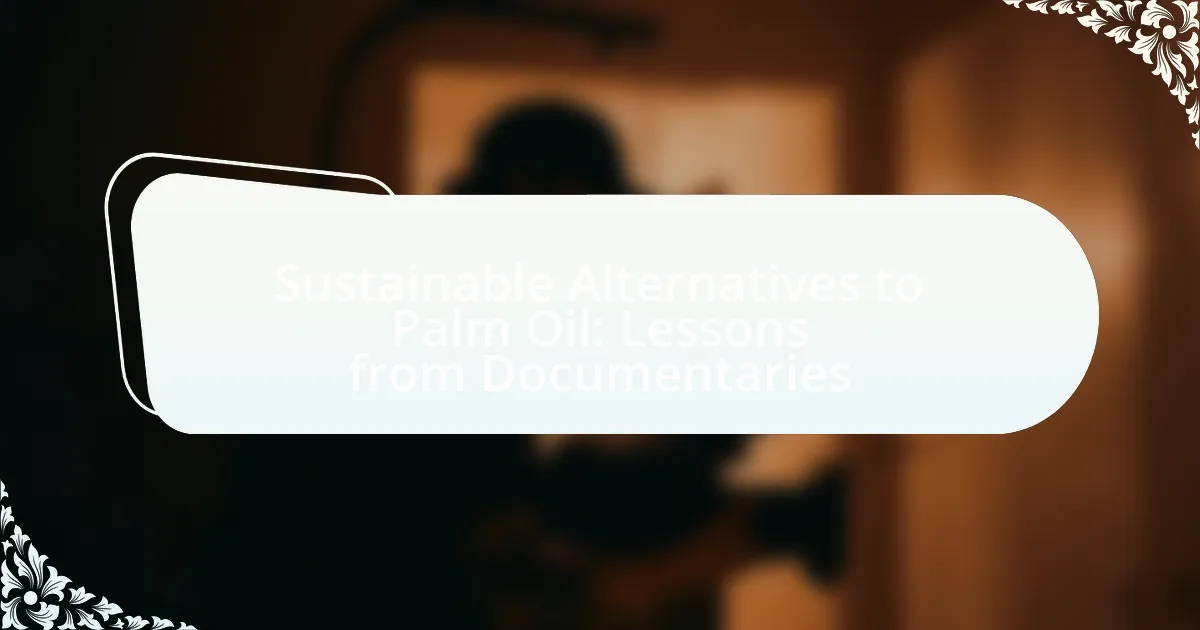The article focuses on sustainable alternatives to palm oil, highlighting oils such as coconut, sunflower, and rapeseed oil, which are produced with less environmental impact. It discusses the urgent need for these alternatives due to the significant ecological damage caused by palm oil production, including deforestation and biodiversity loss. The article also examines the characteristics of sustainable alternatives, the importance of certifications for responsible sourcing, and the role of documentaries in raising awareness about these issues. Additionally, it outlines practical steps consumers can take to support sustainable practices and reduce palm oil consumption.

What are Sustainable Alternatives to Palm Oil?
Sustainable alternatives to palm oil include oils such as coconut oil, sunflower oil, and rapeseed oil. These alternatives are often produced with less environmental impact compared to palm oil, which is linked to deforestation and habitat destruction. For instance, coconut oil is derived from coconuts that can be grown in diverse agroforestry systems, promoting biodiversity. Sunflower oil is often cultivated in crop rotation systems that enhance soil health, while rapeseed oil can be produced in temperate climates with lower pesticide use. According to the World Wildlife Fund, choosing these oils can help reduce the ecological footprint associated with palm oil production.
Why is there a need for alternatives to palm oil?
There is a need for alternatives to palm oil due to its significant environmental impact, including deforestation, loss of biodiversity, and greenhouse gas emissions. The cultivation of palm oil has led to the destruction of approximately 27 million hectares of rainforest, which contributes to habitat loss for endangered species and exacerbates climate change. Additionally, the palm oil industry is linked to social issues such as land rights violations and poor labor conditions. These factors highlight the urgency for sustainable alternatives that can mitigate ecological damage while meeting global demand for vegetable oils.
What environmental impacts are associated with palm oil production?
Palm oil production is associated with significant environmental impacts, primarily deforestation, loss of biodiversity, and greenhouse gas emissions. Deforestation occurs as vast areas of tropical forests are cleared to establish palm oil plantations, leading to habitat destruction for numerous species, including endangered ones like orangutans and tigers. According to a study published in the journal “Nature,” approximately 90% of the world’s palm oil is produced in Indonesia and Malaysia, where deforestation rates have accelerated, contributing to the loss of over 3 million hectares of forest annually. Additionally, the conversion of forests to plantations releases stored carbon dioxide, exacerbating climate change. The World Wildlife Fund reports that palm oil production is responsible for around 10% of global deforestation, highlighting its critical role in environmental degradation.
How does palm oil production affect biodiversity?
Palm oil production significantly reduces biodiversity by leading to habitat destruction, particularly in tropical rainforests. The conversion of these forests into palm oil plantations results in the loss of species-rich ecosystems, threatening numerous plant and animal species with extinction. For instance, the World Wildlife Fund reports that palm oil cultivation has contributed to the decline of orangutan populations, which are critically endangered due to habitat loss in Indonesia and Malaysia. Additionally, monoculture practices in palm oil farming diminish genetic diversity, further destabilizing ecosystems and making them more vulnerable to pests and diseases.
What are the key characteristics of sustainable alternatives?
Sustainable alternatives are characterized by their ability to minimize environmental impact, promote biodiversity, and support social equity. These alternatives often utilize renewable resources, reduce greenhouse gas emissions, and ensure fair labor practices. For instance, sustainable palm oil alternatives, such as coconut or sunflower oil, are cultivated using agroecological methods that enhance soil health and reduce chemical inputs. Research indicates that sustainable practices can lead to a 30% reduction in carbon emissions compared to conventional methods, demonstrating their effectiveness in combating climate change.
How do sustainable alternatives differ from conventional palm oil?
Sustainable alternatives differ from conventional palm oil primarily in their environmental impact and production practices. Conventional palm oil cultivation often leads to deforestation, habitat destruction, and significant greenhouse gas emissions, whereas sustainable alternatives prioritize eco-friendly farming methods, such as agroforestry and organic practices, which reduce carbon footprints and preserve biodiversity. For instance, sustainable palm oil certified by the Roundtable on Sustainable Palm Oil (RSPO) adheres to strict criteria that aim to minimize environmental harm and promote social responsibility, contrasting sharply with the practices associated with conventional palm oil production that frequently disregard these principles.
What certifications indicate sustainability in oil production?
Certifications that indicate sustainability in oil production include the Roundtable on Sustainable Palm Oil (RSPO), the International Sustainability and Carbon Certification (ISCC), and the Rainforest Alliance certification. These certifications ensure that oil production practices meet specific environmental and social criteria, promoting responsible sourcing and minimizing ecological impact. For instance, RSPO requires adherence to principles that protect biodiversity and reduce greenhouse gas emissions, while ISCC focuses on sustainable land use and traceability in the supply chain. Rainforest Alliance certification emphasizes biodiversity conservation and sustainable livelihoods, further validating the commitment to sustainable practices in oil production.

What Lessons Can Be Learned from Documentaries on Sustainable Alternatives?
Documentaries on sustainable alternatives teach critical lessons about environmental impact, consumer choices, and innovative practices. They highlight the importance of understanding the ecological consequences of palm oil production, such as deforestation and biodiversity loss, which can be mitigated through sustainable practices. For instance, documentaries often showcase successful case studies of alternative crops that provide similar economic benefits without the detrimental effects associated with palm oil. These films emphasize the role of consumer awareness and advocacy in driving change, illustrating how informed choices can lead to greater demand for sustainable products. Furthermore, they often present scientific data and expert interviews that validate the effectiveness of sustainable alternatives, reinforcing the message that transitioning to these options is both feasible and necessary for environmental preservation.
How do documentaries raise awareness about sustainable alternatives?
Documentaries raise awareness about sustainable alternatives by presenting compelling narratives that highlight the environmental and social impacts of unsustainable practices. For instance, films like “Before the Flood” and “Our Planet” showcase the consequences of palm oil production, illustrating deforestation and biodiversity loss. These visual stories engage viewers emotionally and intellectually, prompting them to consider sustainable options. Research indicates that documentaries can influence public perception and behavior; a study published in the Journal of Environmental Psychology found that exposure to environmental documentaries significantly increased viewers’ intentions to adopt sustainable practices. By combining factual information with storytelling, documentaries effectively educate audiences and inspire action towards sustainable alternatives.
What storytelling techniques are effective in documentaries?
Effective storytelling techniques in documentaries include the use of narrative structure, character development, and emotional engagement. Narrative structure organizes the content in a way that guides the audience through the story, often employing a beginning, middle, and end to create a compelling arc. Character development allows viewers to connect with individuals affected by the subject matter, making the issues more relatable and impactful. Emotional engagement is achieved through visual storytelling, music, and personal anecdotes, which evoke feelings that resonate with the audience. These techniques have been shown to enhance viewer retention and understanding, as evidenced by successful documentaries that have sparked social movements and policy changes.
How do documentaries influence consumer behavior regarding palm oil?
Documentaries influence consumer behavior regarding palm oil by raising awareness of its environmental and social impacts. For instance, films like “Before the Flood” and “The True Cost” highlight deforestation, habitat destruction, and human rights abuses linked to palm oil production. This exposure often leads consumers to reconsider their purchasing choices, as evidenced by a study published in the journal “Environmental Communication,” which found that viewers of documentaries on palm oil were more likely to seek sustainable alternatives. Consequently, documentaries serve as powerful tools for educating the public and driving demand for ethically sourced products.
What specific documentaries focus on sustainable alternatives to palm oil?
Specific documentaries that focus on sustainable alternatives to palm oil include “The True Cost of Palm Oil,” which examines the environmental and social impacts of palm oil production while highlighting sustainable practices. Another notable documentary is “Before the Flood,” featuring Leonardo DiCaprio, which discusses the broader implications of deforestation, including palm oil, and promotes sustainable alternatives. Additionally, “Our Planet” showcases the importance of biodiversity and sustainable agriculture, indirectly addressing palm oil’s impact and alternatives. These documentaries provide insights into the challenges and solutions related to palm oil sustainability.
What insights do these documentaries provide about the alternatives?
These documentaries provide insights into sustainable alternatives to palm oil, highlighting options such as coconut oil, sunflower oil, and algae-based oils. They emphasize the environmental benefits of these alternatives, including reduced deforestation and lower greenhouse gas emissions compared to palm oil production. For instance, coconut oil is often sourced from smallholder farms that practice agroforestry, which supports biodiversity and soil health. Additionally, the documentaries showcase innovations in algae cultivation, which can produce oil with minimal land use and water consumption, thus presenting a viable solution to the ecological challenges posed by palm oil farming.
How do the documentaries highlight the challenges faced by sustainable producers?
Documentaries highlight the challenges faced by sustainable producers by showcasing the economic pressures, regulatory hurdles, and market competition they encounter. For instance, they often depict how sustainable producers struggle to compete with cheaper, non-sustainable alternatives, which can lead to financial instability. Additionally, these films illustrate the difficulties in obtaining certifications that validate sustainable practices, as seen in the rigorous standards set by organizations like the Rainforest Alliance. Furthermore, documentaries frequently present the environmental challenges, such as climate change and biodiversity loss, that threaten the viability of sustainable production methods. These visual narratives provide concrete examples of the systemic barriers that sustainable producers must navigate to maintain their practices.

What Practical Steps Can Consumers Take to Support Sustainable Alternatives?
Consumers can support sustainable alternatives by choosing products certified by recognized sustainability standards, such as Fair Trade or Rainforest Alliance. These certifications ensure that the products are sourced responsibly, promoting environmental protection and fair labor practices. Additionally, consumers can reduce their demand for palm oil by opting for alternatives like coconut oil or sunflower oil, which have a lower environmental impact. Research indicates that the global demand for palm oil has led to significant deforestation, with approximately 27 million hectares of forest lost between 2000 and 2018 due to palm oil cultivation. By making informed purchasing decisions and advocating for transparency in supply chains, consumers can drive the market towards more sustainable practices.
How can consumers identify sustainable products in the market?
Consumers can identify sustainable products in the market by looking for certifications such as Fair Trade, Rainforest Alliance, and USDA Organic, which indicate adherence to environmental and social standards. These certifications are backed by rigorous assessments and audits that ensure products meet specific sustainability criteria. For example, the Rainforest Alliance certification requires that products are sourced from farms that practice sustainable agriculture, protecting ecosystems and promoting biodiversity. Additionally, consumers can research brands that transparently share their sourcing practices and sustainability initiatives, as companies committed to sustainability often provide detailed information about their supply chains and environmental impact.
What labels or certifications should consumers look for?
Consumers should look for labels and certifications such as RSPO (Roundtable on Sustainable Palm Oil), Fair Trade, and Rainforest Alliance. These certifications indicate that the products meet specific environmental and social standards, ensuring sustainable sourcing practices. For instance, RSPO certification ensures that palm oil is produced sustainably, minimizing deforestation and promoting biodiversity. Fair Trade certification guarantees fair wages and working conditions for farmers, while Rainforest Alliance certification focuses on conserving biodiversity and ensuring sustainable livelihoods. These labels provide consumers with assurance that their purchases support ethical and sustainable practices in the palm oil industry.
How can consumers advocate for sustainable practices in their communities?
Consumers can advocate for sustainable practices in their communities by actively supporting local businesses that prioritize eco-friendly products and practices. By choosing to purchase from these businesses, consumers create demand for sustainable alternatives, which encourages more companies to adopt environmentally responsible methods. Research indicates that consumer preferences significantly influence corporate behavior; for instance, a study by Nielsen found that 66% of global consumers are willing to pay more for sustainable brands. Additionally, consumers can participate in community initiatives, such as local clean-up events or sustainability workshops, which foster awareness and education about sustainable practices. Engaging in discussions with local policymakers to promote regulations that support sustainability can further amplify their impact.
What are some best practices for reducing palm oil consumption?
To reduce palm oil consumption, individuals and organizations can adopt several best practices. First, they can choose products that are certified as palm oil-free or contain sustainably sourced palm oil, as certifications like RSPO (Roundtable on Sustainable Palm Oil) ensure adherence to environmental standards. Additionally, consumers can read ingredient labels carefully to avoid products with palm oil or its derivatives, which are often listed under various names. Furthermore, supporting brands that commit to sustainable practices and transparency in their supply chains can drive demand for alternatives. Research indicates that reducing palm oil consumption can significantly decrease deforestation rates and biodiversity loss, as palm oil production is a leading cause of habitat destruction.
How can consumers make informed choices when shopping for food and products?
Consumers can make informed choices when shopping for food and products by researching product ingredients, understanding labeling, and considering the environmental impact of their purchases. Researching ingredients helps consumers identify harmful additives or allergens, while understanding labeling, such as certifications for organic or fair trade, provides insight into the product’s quality and sourcing practices. Additionally, considering the environmental impact, such as the sustainability of palm oil alternatives, allows consumers to support eco-friendly products. For instance, documentaries on sustainable alternatives to palm oil highlight the benefits of using ingredients like coconut oil or sunflower oil, which can guide consumers toward more responsible choices.
What role do social media and online platforms play in promoting sustainable alternatives?
Social media and online platforms play a crucial role in promoting sustainable alternatives by facilitating awareness, engagement, and community building around environmental issues. These platforms enable organizations and individuals to share information, success stories, and educational content about sustainable practices, such as alternatives to palm oil. For instance, campaigns on platforms like Instagram and Twitter have successfully mobilized public support for sustainable products, leading to increased consumer demand. Research indicates that social media can amplify messages, with studies showing that campaigns can reach millions, significantly impacting consumer behavior and encouraging the adoption of eco-friendly alternatives.

Leave a Reply